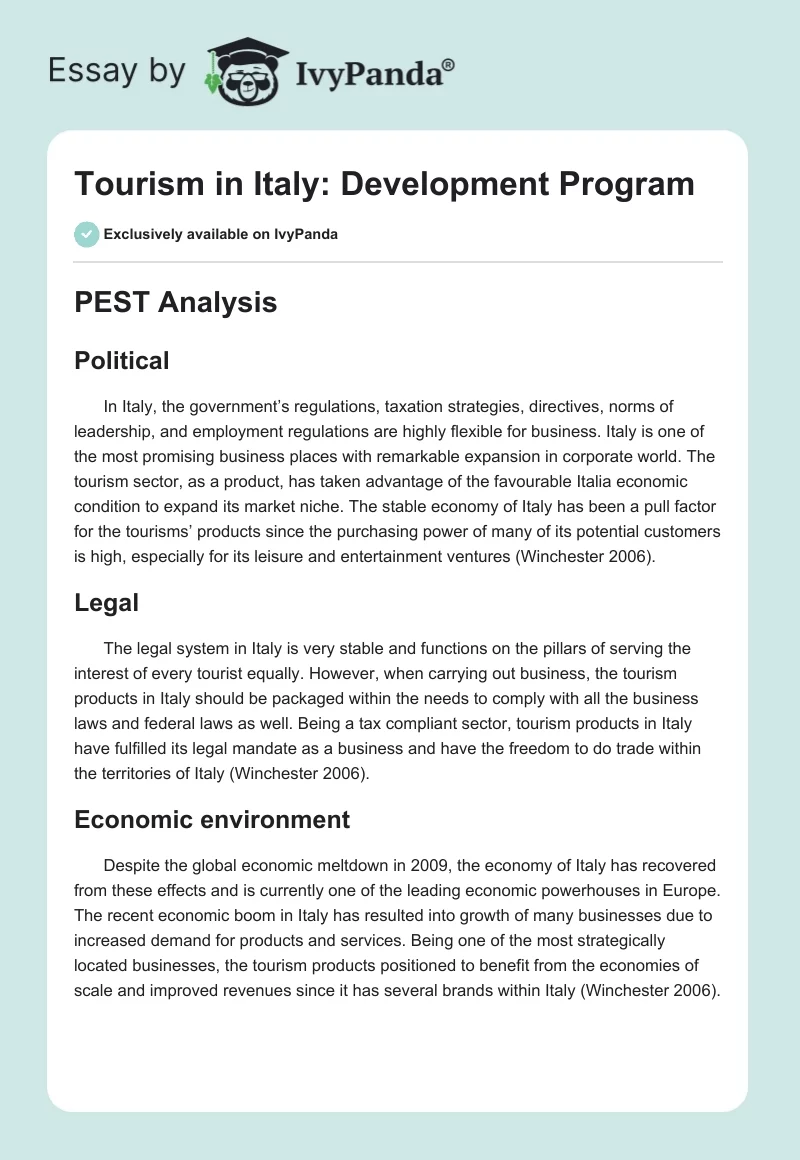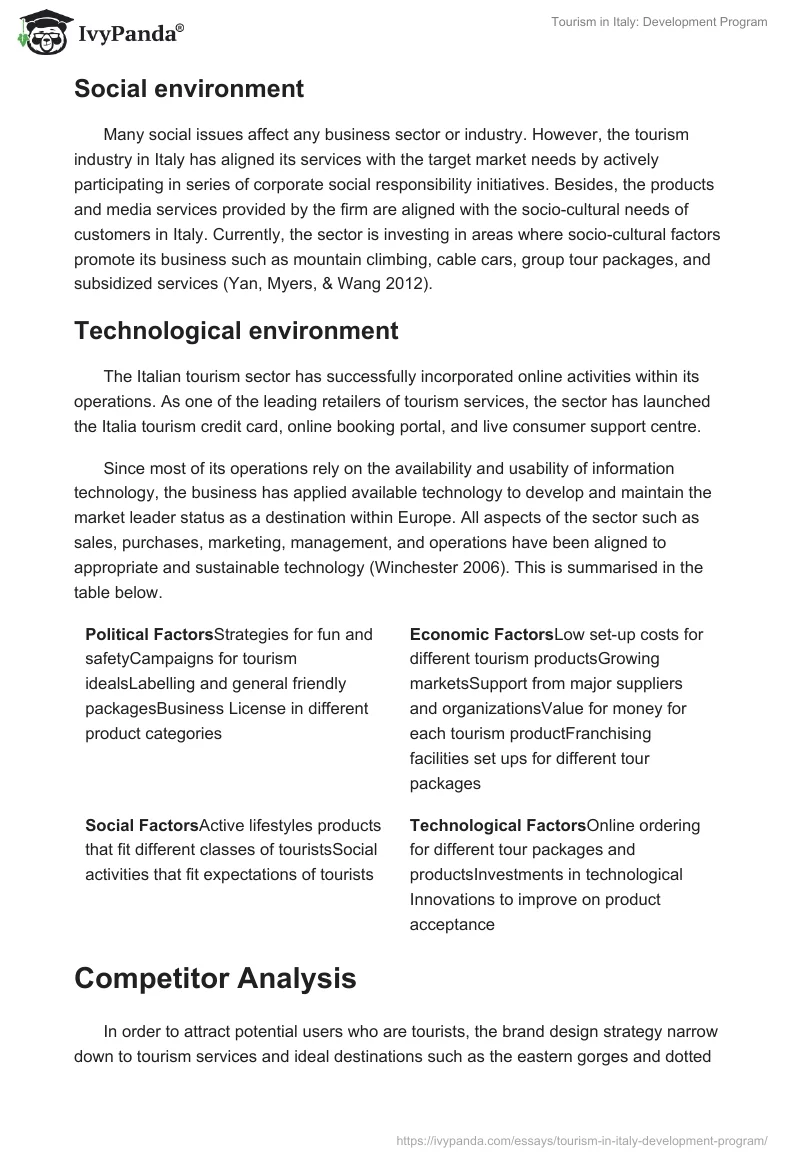PEST Analysis
Political
In Italy, the government’s regulations, taxation strategies, directives, norms of leadership, and employment regulations are highly flexible for business. Italy is one of the most promising business places with remarkable expansion in corporate world. The tourism sector, as a product, has taken advantage of the favourable Italia economic condition to expand its market niche. The stable economy of Italy has been a pull factor for the tourisms’ products since the purchasing power of many of its potential customers is high, especially for its leisure and entertainment ventures (Winchester 2006).
Legal
The legal system in Italy is very stable and functions on the pillars of serving the interest of every tourist equally. However, when carrying out business, the tourism products in Italy should be packaged within the needs to comply with all the business laws and federal laws as well. Being a tax compliant sector, tourism products in Italy have fulfilled its legal mandate as a business and have the freedom to do trade within the territories of Italy (Winchester 2006).
Economic environment
Despite the global economic meltdown in 2009, the economy of Italy has recovered from these effects and is currently one of the leading economic powerhouses in Europe. The recent economic boom in Italy has resulted into growth of many businesses due to increased demand for products and services. Being one of the most strategically located businesses, the tourism products positioned to benefit from the economies of scale and improved revenues since it has several brands within Italy (Winchester 2006).
Social environment
Many social issues affect any business sector or industry. However, the tourism industry in Italy has aligned its services with the target market needs by actively participating in series of corporate social responsibility initiatives. Besides, the products and media services provided by the firm are aligned with the socio-cultural needs of customers in Italy. Currently, the sector is investing in areas where socio-cultural factors promote its business such as mountain climbing, cable cars, group tour packages, and subsidized services (Yan, Myers, & Wang 2012).
Technological environment
The Italian tourism sector has successfully incorporated online activities within its operations. As one of the leading retailers of tourism services, the sector has launched the Italia tourism credit card, online booking portal, and live consumer support centre.
Since most of its operations rely on the availability and usability of information technology, the business has applied available technology to develop and maintain the market leader status as a destination within Europe. All aspects of the sector such as sales, purchases, marketing, management, and operations have been aligned to appropriate and sustainable technology (Winchester 2006). This is summarised in the table below.
Competitor Analysis
In order to attract potential users who are tourists, the brand design strategy narrow down to tourism services and ideal destinations such as the eastern gorges and dotted sandy beaches. This ensures that accurate information is correctly reflected besides saving time which is of essence to different classes of tourists. The value proportion of this strategy is capable of tracking past records which have been fed in the computer system on tourists turn out and response on service quality and affordability.
In addition, the branding of tourism as a product created direct value for money spent (Sharp, Riebe, & Dawes 2002). As a matter of fact, players in the tourism industry of Italy have been given the opportunity to customize the application to fit into their system and fully control flow of information on tourists’ turn over.
Different models of brand exist from simple to complex models for larger international companies which aim to cut a niche in the competitive market. This has been made possible by technological revolution and inventions aimed at remodelling efficiency, reducing redundancy, and embracing systematic orientations in the Italian tourism products.
Stakeholder Analysis
Proposed New Tourism Development
There is need to increase the scope of operations through strategic and innovative ideas of tourism service delivery to customers. There is also need to provide efficient, cost effective, and comprehensive tourism transport logistics services to customers (Shimp 2007). This is possible through incorporation of new features to the existing transportation service so as to cater to the changing demands and needs of the targeted customers.
This may be achieved through complete transport chain automation for different tour packages to different regions within the targeted location. In order to succeed with this plan, there is need for excellent marketing, advertisement and promotional strategies to win the confidence and loyalty of the customers in the proposed changes in the transport system (Robbins & Coulter 2012).
The success of the proposed plan will be dependent on soft artful skills which are part and parcel of the current system of management aimed at providing efficient, cost effective, and comprehensive transport logistics services to customers. For implementation of the strategy, the management is to balance both the short term and long term considerations towards decision making to ensure that the goal of increasing scope of operations through strategic and innovative ideas of transport service delivery to customers is achieved at the optimal operational and strategic model.
There is need to incorporate a quality operations management system to guarantee the interests of the stakeholders (Hakala, Svensson, & Vincze 2012). Moreover, balancing act between having to perform optimally at minimal operation and overhead costs is a component of quality in system modelling that must be remodelled to guarantee optimal returns for the stakeholders’ equity.
Besides improved transport system, there is need to introduce o improve the current green services. The notable green practices in the current lodging include paperless services, solar water heaters, natural air fans, underground floor heating system from natural solar, and energy saver bulbs. Besides, the bathrooms are fitted with water saver flashers and showers. The hotel rooms are well lit because of large windows. Thus, electricity for lighting is only used at night. However, the swimming pools in the hotels should be heated by a green energy source.
Reference List
Hakala, U, Svensson, J, & Vincze, Z 2012, “Consumer-based brand equity and top-of-mind awareness: a cross-country analysis,”Journal of Product & Brand Management, vol. 21 no. 6, pp.439-451.
Robbins, S, & Coulter, M 2012, Management, Prentice Hall, Upper Saddle River.
Sharp, B, Riebe, E, & Dawes, J 2002, “A Marketing Economy of Scale-Big Brands Lose less of their Customer Base than Small Brands,” Marketing Bulletin Journal, vol. 13 no. 1, pp. 1-8.
Shimp, T 2007, Advertising, promotion, and other aspects of integrated marketing communications, Thomson South-Western: Mason, Ohio.
Winchester, M 2006, “Positive and negative brand beliefs and brand defection/uptake,” European Journal of Marketing, vol. 42 no. 6, pp. 553-570.
Yan, R, Myers, A, & Wang, J 2012, “Price strategy, information sharing, and firm performance in a market channel with a dominant retailer,”Journal of Product & Brand Management, vol. 21 no. 6, pp.475-485.


